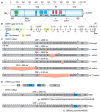Alternative Splicing of Human Telomerase Reverse Transcriptase (hTERT) and Its Implications in Physiological and Pathological Processes
- PMID: 34065134
- PMCID: PMC8150890
- DOI: 10.3390/biomedicines9050526
Alternative Splicing of Human Telomerase Reverse Transcriptase (hTERT) and Its Implications in Physiological and Pathological Processes
Abstract
Alternative splicing (AS) of human telomerase catalytic subunit (hTERT, human telomerase reverse transcriptase) pre-mRNA strongly regulates telomerase activity. Several proteins can regulate AS in a cell type-specific manner and determine the functions of cells. In addition to being involved in telomerase activity regulation, AS provides cells with different splice variants that may have alternative biological activities. The modulation of telomerase activity through the induction of hTERT AS is involved in the development of different cancer types and embryos, and the differentiation of stem cells. Regulatory T cells may suppress the proliferation of target human and murine T and B lymphocytes and NK cells in a contact-independent manner involving activation of TERT AS. This review focuses on the mechanism of regulation of hTERT pre-mRNA AS and the involvement of splice variants in physiological and pathological processes.
Keywords: alternative splicing; apoptosis; endonuclease G; human telomerase reverse transcriptase (hTERT); lymphocytes; splice variants; telomerase; telomeres.
Conflict of interest statement
Authors declare no conflict of interests.
Figures





Similar articles
-
Physiological and pathological significance of human telomerase reverse transcriptase splice variants.Biochimie. 2013 Nov;95(11):1965-70. doi: 10.1016/j.biochi.2013.07.031. Epub 2013 Aug 9. Biochimie. 2013. PMID: 23933091 Review.
-
Alternative splicing of telomerase catalytic subunit hTERT generated by apoptotic endonuclease EndoG induces human CD4+ T cell death.Eur J Cell Biol. 2017 Oct;96(7):653-664. doi: 10.1016/j.ejcb.2017.08.004. Epub 2017 Sep 1. Eur J Cell Biol. 2017. PMID: 28886883
-
[Apoptotic endonuclease EndoG induces alternative splicing of telomerase catalytic subunit hTERT and death of tumor cells].Biomed Khim. 2016 Mar;62(3):239-50. doi: 10.18097/PBMC20166203239. Biomed Khim. 2016. PMID: 27420614 Russian.
-
Intracellular Localization of Apoptotic Endonuclease EndoG and Splice-Variants of Telomerase Catalytic Subunit hTERT.Biochemistry (Mosc). 2017 Aug;82(8):894-905. doi: 10.1134/S0006297917080041. Biochemistry (Mosc). 2017. PMID: 28941457
-
Alternative Splicing of hTERT Pre-mRNA: A Potential Strategy for the Regulation of Telomerase Activity.Int J Mol Sci. 2017 Mar 7;18(3):567. doi: 10.3390/ijms18030567. Int J Mol Sci. 2017. PMID: 28272339 Free PMC article. Review.
Cited by
-
Spotlight on hTERT Complex Regulation in Cutaneous T-Cell Lymphomas.Genes (Basel). 2023 Feb 8;14(2):439. doi: 10.3390/genes14020439. Genes (Basel). 2023. PMID: 36833366 Free PMC article.
-
Counteracting Immunosenescence-Which Therapeutic Strategies Are Promising?Biomolecules. 2023 Jul 6;13(7):1085. doi: 10.3390/biom13071085. Biomolecules. 2023. PMID: 37509121 Free PMC article. Review.
-
Inhalation of concentrated ambient PM2.5 promotes inactivation of telomerase reverse transcriptase, telomere shortening, and senescence of multiple cell types in mice.Toxicol Sci. 2025 Jul 1;206(1):147-157. doi: 10.1093/toxsci/kfaf045. Toxicol Sci. 2025. PMID: 40172909
-
Special Issue: "Telomerase: Role in Health and Aging".Biomedicines. 2022 Nov 17;10(11):2957. doi: 10.3390/biomedicines10112957. Biomedicines. 2022. PMID: 36428525 Free PMC article.
-
Combining old and new concepts in targeting telomerase for cancer therapy: transient, immediate, complete and combinatory attack (TICCA).Cancer Cell Int. 2023 Sep 7;23(1):197. doi: 10.1186/s12935-023-03041-2. Cancer Cell Int. 2023. PMID: 37679807 Free PMC article. Review.
References
Publication types
Grants and funding
LinkOut - more resources
Full Text Sources
Research Materials

